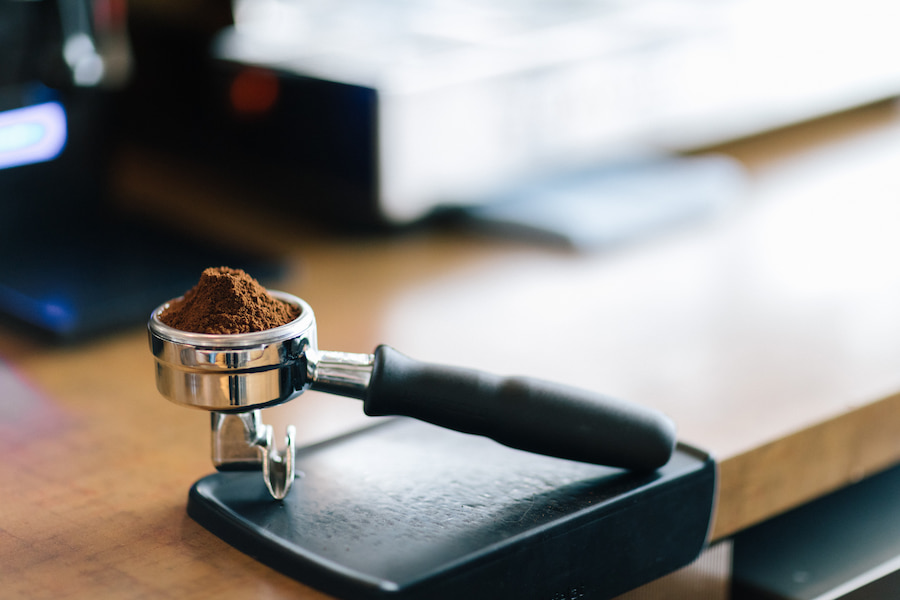If you’re an espresso lover, you know that a good cup of coffee starts with a proper tamp. However, what if you don’t have a tamper, or if you’re traveling and didn’t carry your tamper? I’m covering how to tamp espresso without a tamper.
Contents
How to Tamp Espresso Without a Tamper
When steeping espresso without a tamper, you can use an ordinary spoon or even your thumb. You might also want to experiment with a cloth or a shot glass and see what works best for you.
These four methods are easy to do and don’t require special equipment. You can find all the materials you need in your kitchen. Make sure to use a consistent tamping pressure, and don’t forget to clean your machine after each use.

Using a Shot Glass
If you don’t have a tamper, a shot glass is the most suitable household object for tamping. Always ensure your shot glass by rinsing it in running water and drying it before using.
- Put grounded espresso into your filter and fill it up just enough. It is best to ensure your mound is at least an inch higher than your fill line.
- Next, take your shot glass and carefully push it onto the mound so that no grounds escape.
- With one quick motion, carefully remove the shot glass. Ensure there aren’t any grounds on the edge of your filter, and it’s good to go.
Using a Spoon
When using a spoon, use the back of the spoon, not the bowl of it. The goal is to apply even pressure, so it’s best to use something that won’t bend (avoid plastic spoons). Follow these steps when tamping with a spoon:
- Place your grounds in the filter.
- Hold the spoon in your dominant hand and place the back of it on top of the grounds.
- Apply pressure to the spoon’s handle with your thumb, using an even circular motion.
- Continue applying pressure until the coffee is level with the top of the filter.
- Remove the spoon and place the filter in the machine.
- Brew your espresso as usual.
Using Your Thumb
If you don’t have a tamper, your thumb can be an adequate stand-in. First, make sure your espresso is ground to the correct consistency (fine, however, not too fine). The water will flow right through if it’s too fine, and the shot will be over-extracted and bitter.
Once your grounds are ready, hold your thumb over the top of the portafilter and gently shake it back and forth so the grounds settle evenly. Then, apply gentle pressure to level off the mound of grounds.
Be careful not to press too hard, or you’ll compress the grinds too much and end up with a weak shot. Now you’re ready to brew, and in a few short minutes, you’ll have a delicious cup.
Using a Piece of Cloth
The other method is to take a small cloth and fold it into a square. Once you have done this, you will need to hold the fabric in one hand and use the other hand to apply pressure to the grounds. You should start from the outside of the tamper and work your way in.
Apply as much pressure as you can without crushing the grounds. Once you have applied enough pressure, you can remove the cloth and dispose of it; your espresso is now ready to be brewed. Make sure to use a clean piece of cloth for each shot.
What Is Espresso Tamping?
Tamping is compressing coffee grounds in an espresso machine’s portafilter before brewing. This step is crucial to making a good cup, as it reduces the air level in the filter while concentrating the grinds.
Tamping coffee grounds evenly is also essential, as it helps ensure that the water flows through all of the coffee. Tamping is done using a tamper, a small tool that fits inside the portafilter.
Benefits of Espresso Tamping
A good tamp ensures that the coffee grounds are evenly extracted, which is vital to the overall flavor, uniformity, and consistency throughout each cup brewed with this technique. Other benefits of tamping include greater water resistance, reduced residue in the cup, and your espresso staying warmer for longer.
Sufficient Crema Production
It allows for proper crema production. Crema is the delicious, foamy layer on top of espresso rich in flavor. It comprises coffee oils, dissolved gasses, and tiny coffee particles.

Reduces Residue
This process helps create a clean cup with no residue. When coffee isn’t tamped properly, the grounds can overflow the portafilter and end up in your cup. Tamping helps to keep all of the coffee in the filter and results in a clean cup every time.
Stabilizes Temperature of Coffee
Tamping assists in maintaining the temperature of your espresso. If coffee isn’t tamped properly, it can cause fluctuations in the brewing temperature. This can impact the flavor and quality of your espresso.
Uses Less Coffee Grounds
Tamping lets you use less coffee. When tamping, you can pack the grounds more densely into the portafilter. This means that you can use less coffee without sacrificing flavor or quality.
Prevents a Bitter Aftertaste
Tamping prevents bitterness. If the grounds are too loosely packed, the espresso will be over-extracted and taste bitter. Tamping also ensures that the grounds are just densely packed enough to extract all of the flavors without becoming bitter.
What Is the Ideal Tamping Pressure?
The ideal tamping pressure is around 30 pounds. This may seem like a lot. However, it’s not that much when you consider the surface area of the coffee grounds.
Applying too much pressure can result in over-extraction and bitter espresso. Using too little pressure can result in under-extraction and weak espresso. So, the key is to find the perfect balance.
Final Thoughts
The proper technique for how to tamp espresso without a tamper is important in getting proper water extraction during the brewing process in your espresso machine so no channels form between grounds which would result in a bad-tasting flavor due to a lack of desirable taste profiles. Whatever method you choose, always keep pulse pressure consistent throughout.


